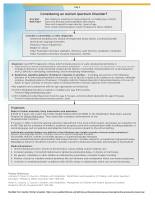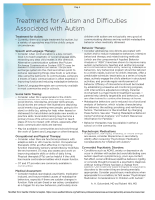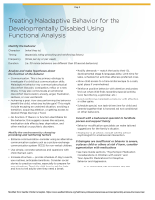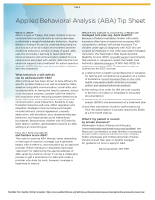Introduction and Overview
The following resources are widely used in clinical settings to screen and assess, design treatment protocol, prescribe medication and provide referrals for children and adolescents with symptoms of Autism Spectrum Disorder.
Screening & Assessment
 Considering an Autism Spectrum Disorder
Considering an Autism Spectrum Disorder
Flowchart to guide diagnosis and treatment of individuals with symptoms of autism spectrum disorder.
Treatment
Evidence-Based Treatments for Substance Use Disorders
 Treatments for Autism and Difficulties Associated with Autism
Treatments for Autism and Difficulties Associated with Autism
Speech Language Therapy, Behavior Therapy, Social Skills Training, Psychotropic Medications, Occupational and Physical Therapy, Medical Assessment, and Co-morbid Psychiatric Disorders
 Treating Maladaptive Behavior for the Developmentally Disabled Using Function Analysis
Treating Maladaptive Behavior for the Developmentally Disabled Using Function Analysis
Assessment to determine factors that influence behaviors.
 Applied Behavioral Analysis (ABA) Tip Sheet
Applied Behavioral Analysis (ABA) Tip Sheet
Therapeutic approach to support individuals in improving communication and social skills as well as decreasing maladaptive behaviors.
Referral and Co-Management
- Montana Autism Center: Information for families and professionals, age-related Montana services, policies/waivers, education blogs, etc.
Medication
Medications do not improve core autism features; i.e. there is currently no “autism medication.” Listed below are some things to consider.
Behavioral or Counseling Treatments
Consider augmenting behavioral or counseling treatments with medications if there is moderate to severe distress and dysfunction in an area noted to be medication responsive.
Single Medication
Use a single medication appropriate to a diagnosis or target symptom. Start low and increase slowly.
Track Target Symptom's
Track the target symptom's response to interventions.
Be Skeptical
Be skeptical about the utility of medicines that "work" for only a couple of weeks before a dose increase seems to be required — it is not safe to increase medicine doses indefinitely beyond the normal dosage range.
Reevaluate
If an intervention isn't reducing symptoms, taper and remove the medication, then reevaluate. Be vigilant about stopping any medication that is not clearly helpful.
Wean Off
A history of past benefit from a medication does not necessarily mean there is continued benefit from ongoing use. Periodic attempts to wean off a previously helpful medication (such as annually) will reveal if ongoing use of that medicine is desirable.
Maximum Dose
Do not exceed maximum dose recommendations for typically developing children. Note children with autism typically experience more adverse effects than others do from psychotropic medications.
ADHD
Consider stimulants if an ADHD comorbidity, though they may have less benefit on ADHD symptoms than children without autism. They also have more adverse effects than children without autism, including more irritability, insomnia and social withdrawal.
If hyperactivity and impulsivity are the main issues, consider guanfacine or very low dose clonidine (both have long acting forms if the child can swallow pills). The main side effects are sleepiness and potentially irritability.
Anxiety
Many children with autism are anxious. This may lead to reactive, emotional outbursts. SSRIs, often at very low doses, can improve behavior and function. They have a better side effect profile than Antipsychotics, but have a higher rate of adverse effects including agitation, irritability, elation and insomnia than for children without autism.
Risperidone and Aripiprazole
Risperidone and Aripiprazole are both FDA approved for children (Risperdal 5-17; aripiprazole 6-17) with irritability, aggression, self-injury and quick mood swings associated with autism. These can be used if behavioral therapy is yielding inadequate results on severe symptoms.
Children ≥5 years and Adolescents
Note: Individualize dose according to patient response and tolerability.
15 to 20 kg: Oral: Initial: 0.25 mg/day; after ≥4 days, may increase dose to 0.5 mg/day; maintain this dose for ≥14 days. In patients not achieving sufficient clinical response, may increase dose in increments of 0.25 mg/day at ≥2-week intervals. Doses ranging from 0.5 to 3 mg/day have been evaluated; however, therapeutic effect reached plateau at 1 mg/day in clinical trials. Following clinical response, consider gradually decreasing dose to lowest effective dose. May be administered once daily or in divided doses twice daily.
≥20 kg: Oral: Initial: 0.5 mg/day; after ≥4 days, may increase dose to 1 mg/day; maintain this dose for ≥14 days. In patients not achieving sufficient clinical response, may increase dose in increments of 0.5 mg/day at ≥2-week intervals. Doses ranging from 0.5 to 3 mg/day have been evaluated; however, therapeutic effect reached plateau at 2.5 mg/day (3 mg/day in pediatric patients >45 kg) in clinical trials. Following clinical response, consider gradually decreasing to lowest effective dose. May be administered once daily or in divided doses twice daily.
Fluoxetine
Repetitive behavior associated with autism spectrum disorders (ASD):
Limited data available.
- Children ≥5 years and Adolescents: Oral:
- Start at: 2.5 mg once daily for 7 days
- Titration schedule at weekly intervals using weight-based dosing: 0.3 mg/kg/day during week 2; followed by 0.5 mg/kg/day during week 3
- Maximum of 0.8 mg/kg/day; mean final dose: 9.9 mg/day (range: 2.4 to 20 mg/day)
Escitalopram
Limited data available.
- Comes in oral form for children and adolescents 6 to 17 years
- Start at: 2.5 mg once daily
- Titration schedule to effects: may increase if needed to 5 mg/day after 1 week; may then increase at weekly intervals by 5 mg/day if needed and as tolerated
- Maximum dose: 20 mg/day
Billing/Coding
NA for this topic
Additional Resources for Families
Websites
- Autism Speaks: Advocacy, diagnostic, treatment and support resources.
- Autism Center: University of Washington — advocacy, diagnostic, treatment and support resources.
- ARC Washington State: Parent to Parent peer mentorship program.
Podcast
- Adventures in Autism: A family’s experience with their son, Logan. Megan Carranza speaks with parents, siblings, experts in the field, and people with autism.
Apps
- CDC’s free milestone tracker app: Tracks milestones from 2 months to 5 years with easy-to-use illustrated checklists.
- Reading Rocket (2020) shares Apps for Children with Autism focused on emotional regulation, language and communication, routines, schedules and organizations, and social skills.
Articles
Asperger Experts Articles: Get help & hope from those who've lived it with these stories, examples and explanations.
Books
- Children with Autism: A Parent’s Guide (2000), by Michael D. Powers
- A Parent’s Guide to Asperger Syndrome and High-functioning Autism: How to Meet the Challenges and Help Your Child Thrive (2002), by Sally Ozonoff, Geraldine Dawson, and James McPartlan
Videos
- Aging Out: Autism In Montana Follow Montana families as they recognize their fears and explore their options for the future.
Resources for Teaching Social Skills
All Ages:
- The Social Skills Picture Book: Teaching Play, Emotion, and Communication to Children with Autism (2003), by Jed Baker (Future Horizons)
- The New Social Story Book, Illustrated Edition (2000), by Carol Gray (Linguisystems)
Preschool-Kindergarten:
- Skillstreaming in Early Childhood: Teaching Prosocial Skills to the Preschool and Kindergarten Child (1990), book and program forms booklet, by Ellen McGinnis and Arnold Goldstein (Research Press)
- Do, Watch, Listen, Say (2000), by Kathleen Ann Quill (Thinking Publications)
Elementary Grades (1st through 4th):
- Social Star: General Interaction Skills (Book 1)
- Social Star: Peer Interaction Skills (Book 2)
- Social Star: Conflict Resolution and Community Interaction Skills (Book 3), by Nancy Gajewski, Patty Hirn, and Patty Mayo (Thinking Publications)
- Skillstreaming the Elementary School Child: New Strategies and Perspectives for Teaching Prosocial Skills (1997), by Ellen McGuinnis and Arnold Goldstein (Research Press)
- Comic Strip Conversations (1994), by Carol Gray (Thinking Publications)
Adolescents:
- SSS: Social Skills Strategies Book A and SSS: Social Skills Strategies Book B (1989), by Nancy Gajewski and Patty Mayo (Thinking Publications)
- Navigating the Social World: A Curriculum for Individuals with Asperger’s Syndrome, High Functioning Autism and Related Disorders (2001), by Jeanette McAfee, MD (Future Horizon)
- Inside Out: What Makes the Individual with Social-Cognitive Issues Tick? (2000), by Michelle Garcia Winners (Thinking Publications)
Board Games and Online Games:
- 10 Say and Do Positive Pragmatic Game Boards (Super Duper Publications)
- The Non-Verbal Language Kit (ages 7-16, Linguisystems)
- Do 2 Learn:Free games that teach about feelings and facial expressions
Picture Exchange Communication System (PECS) resource:
- Do 2 Learn: Has pictures that can be printed out for arranging a visual daily schedule




